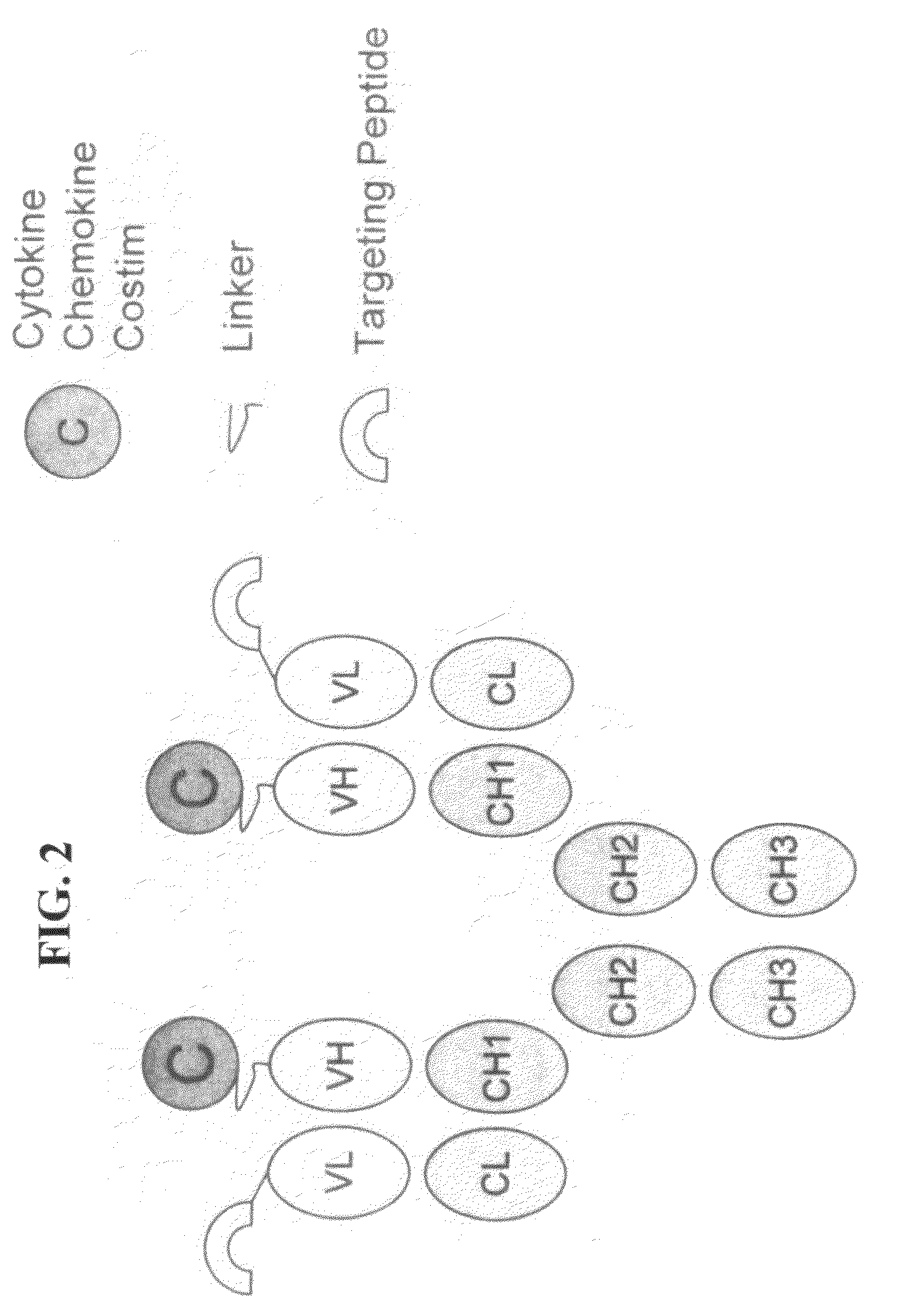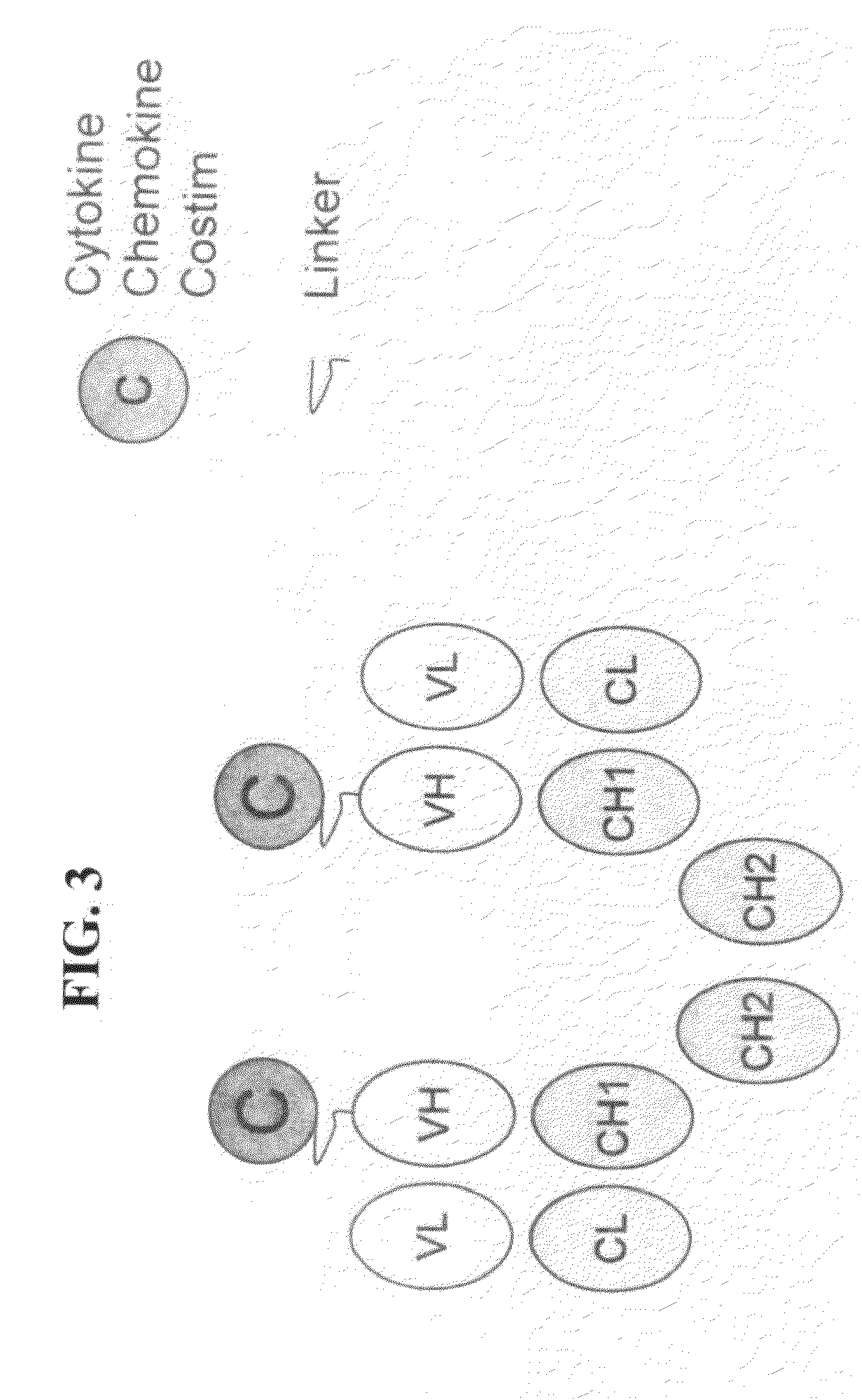Engineered fusion molecules immunotherapy in cancer and inflammatory diseases
a technology of fusion molecules and cytotoxic t cells, applied in the direction of fusions for specific cell targeting, antibody medical ingredients, drug compositions, etc., can solve the problems of difficult generation of cytotoxic response, difficult efforts, and frequent interference of immune response development and function, and achieve the effect of improving current antigen-specific cytotoxic t cell mediated therapies and promoting optimal activation of t cells
- Summary
- Abstract
- Description
- Claims
- Application Information
AI Technical Summary
Benefits of technology
Problems solved by technology
Method used
Image
Examples
example 1
[0060]This Example describes the preparation of genetically engineered molecules comprising a tumor targeting moiety and a chemokine. In this example, the chemokine is fractalkine or MCP-1 and the tumor targeting moiety is an anti-her2 / neu antibody. The molecule will be constructed as depicted in FIG. 1, with the fractalkine molecule (full length or truncated) or MCP-1 molecule attached via a linker to the heavy chain (HC)(e.g., IGN02 / 03 / 04 / 06 below) or light chain (LC)(e.g., IGN01 below) of the antibody. The molecules in this example were prepared using methods and techniques well known and understood by one of ordinary skill in the art.
[0061]The preparation of the engineered molecules can be generally described as follows: 1) the full gene sequence of interest is synthesized by the most appropriate method, e.g., direct gene synthesis, overlap PCR methodologies, and / or restriction-ligation techniques, for such gene; 2) the synthesized gene sequence is incorporated into an appropria...
example 2
[0064]In this Example, the molecules of Example 1 were tested and evaluated head-to-head with commercially available Herceptin® in a SKBR-3 breast cancer cell binding assay and in an ADCC assay.
Cell Binding
[0065]Binding of the IGN01-06 molecules to SKBR-3 breast cancer cells was measured by two methods. In the first method, a labeled antibody to CX3CL1(fractalkine)(R&D Systems Cat. No. IC365P) was used. By binding to the fractalkine moiety of the fusion proteins, this antibody acted as a secondary antibody for the detection of the cell-bound antibody of interest. In the second method, a labeled anti-human IgG (Jackson ImmunResearch Cat. No. 109-096-088) was used to bind to the IgG moiety of the fusion proteins. Both of these antibodies were used at a fixed concentration of 5 ug / ml.
[0066]The results of these studies are shown below. Binding curves for anti-IgG and CX3CL1 are shown in FIGS. 8 and 9, respectively. The relative binding is shown in Table 1. The values in FIGS. 8 and 9 ar...
example 3
[0070]This Example describes the preparation of a genetically engineered molecule comprising a tumor targeting moiety and a costimulatory molecule. In this example, the costimulatory molecules is OX40L, 41BBL, or CD86 and the tumor targeting moiety is an anti-her2 / neu antibody. The molecule will be constructed as depicted in FIG. 1, with the costimulatory molecule (full length or truncated) attached via a linker to the heavy chain (VH) of the antibody. The molecule will be prepared using the methods described herein. The molecule will be tested and evaluated in a cell based assay involving tumor cells and T cells and wherein said tumor cell can not normally costimulate or activate T cells. Importantly, because the tumor targeting moiety of the engineered molecule will bind the tumor and display the costimulatory molecule on the surface of the tumor, the molecule will effectively activate T cells and help in killing the tumor, thereby improving on current antigen-specific cytotoxic T...
PUM
| Property | Measurement | Unit |
|---|---|---|
| concentration | aaaaa | aaaaa |
| concentration | aaaaa | aaaaa |
| pharmaceutical composition | aaaaa | aaaaa |
Abstract
Description
Claims
Application Information
 Login to View More
Login to View More - R&D
- Intellectual Property
- Life Sciences
- Materials
- Tech Scout
- Unparalleled Data Quality
- Higher Quality Content
- 60% Fewer Hallucinations
Browse by: Latest US Patents, China's latest patents, Technical Efficacy Thesaurus, Application Domain, Technology Topic, Popular Technical Reports.
© 2025 PatSnap. All rights reserved.Legal|Privacy policy|Modern Slavery Act Transparency Statement|Sitemap|About US| Contact US: help@patsnap.com



